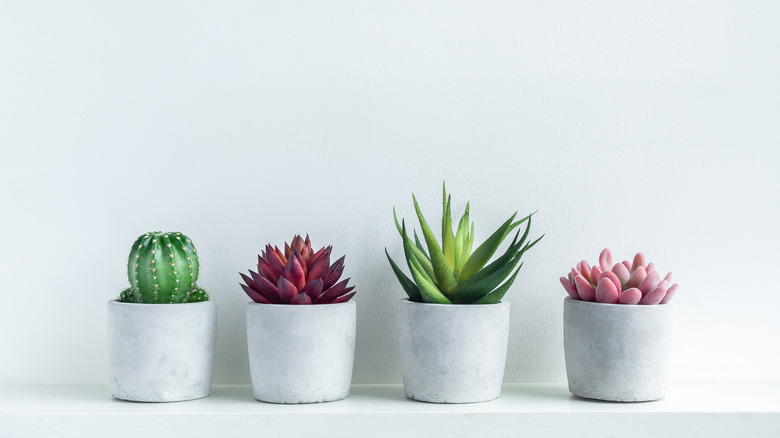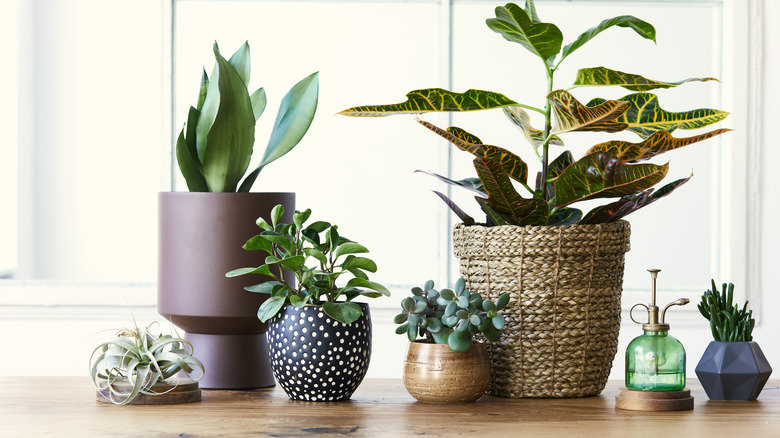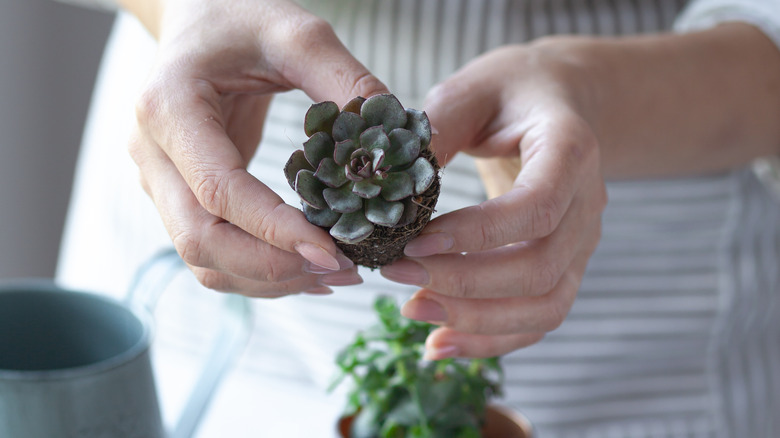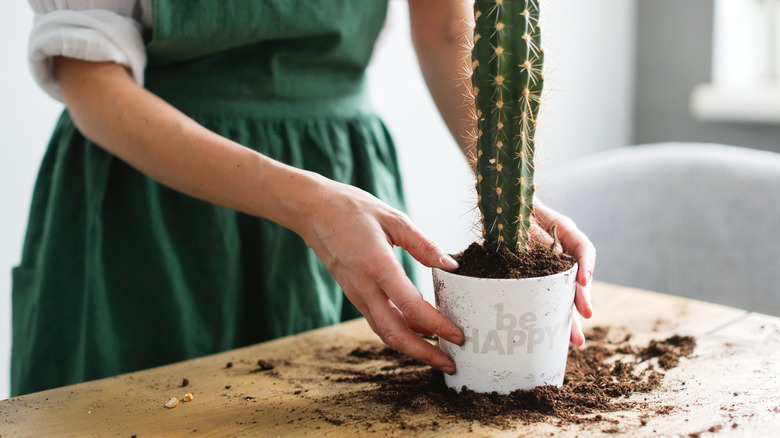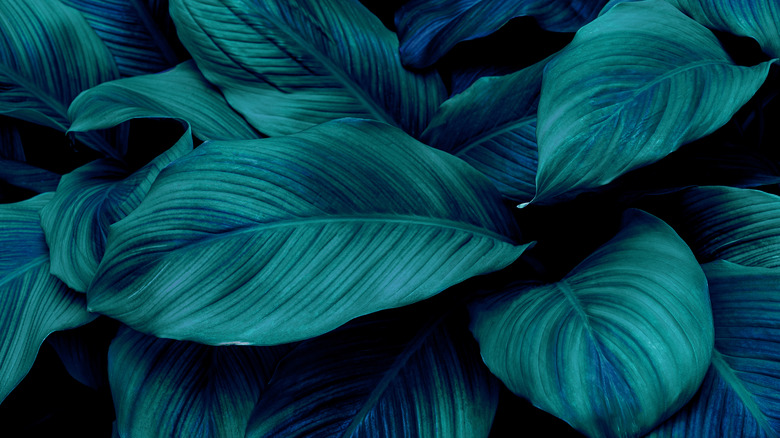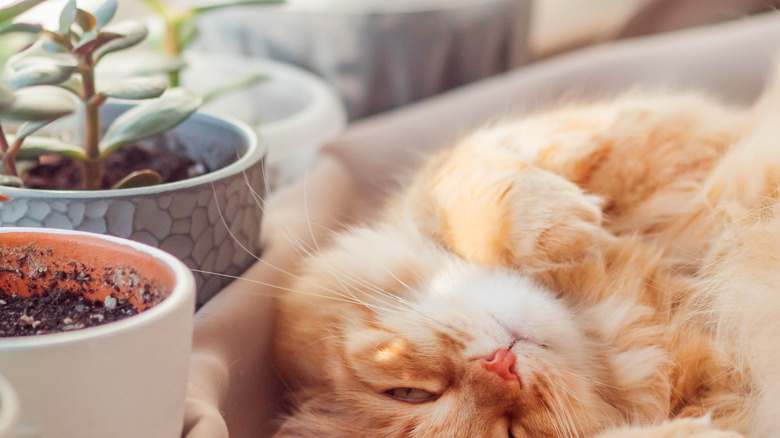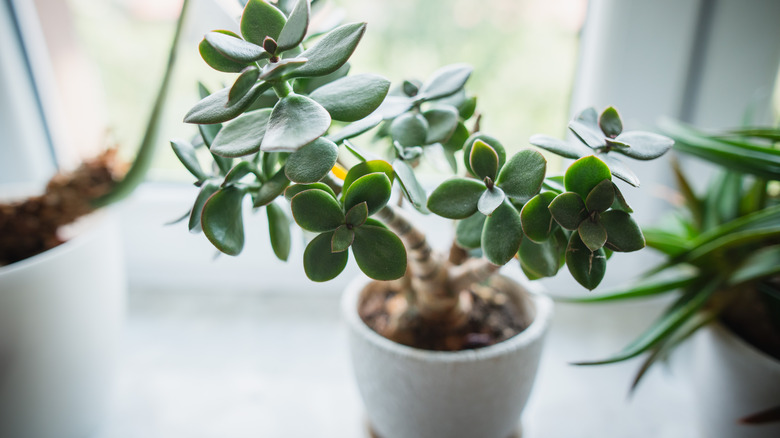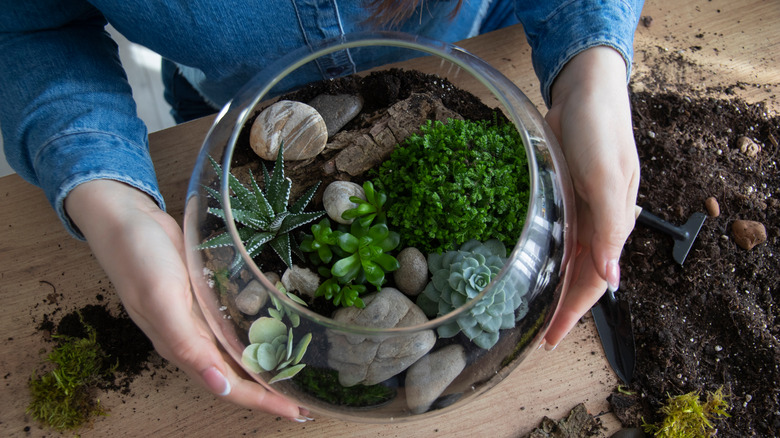Can You Use Cactus Soil For Succulents
Caring for succulents has become a huge hobby in the modern world across all segments of the consumer market. Older Americans alongside millennials are leaning into the addition of succulents to their home gardens, windowsills, and desk space — either as a colorful addition to a home office or as durable shrubbery that needs little attention in a shared workspace in corporate offices, as per Succulent Plant Care.
There are many different ways that you can utilize succulents around the home or garden, and there are really no incorrect ways to decorate a space with these fascinating plants. A few rules of thumb come into play, however, when planting new succulents or caring for an existing patch of them. Firstly, it's incredibly easy to overwater a succulent, so if in doubt, don't add more liquid to the environment, warns New York Magazine's The Cut. Additionally, succulents require well-draining soil, and a specialized cactus potting mix is a great choice for nearly all applications. From soil to the continued propagation of new succulent branch-offs, the world of these hardy plants is well worth your time.
How to use succulents in the home
Succulents have come to find a perennial home on the desks of college students and office workers these days. They make for a great gift for any loved one or friend and can add a uniquely colorful flair to a typically drab workspace setup. Because succulents require a minuscule amount of water and marginal sunlight to thrive, they make for a great windowsill addition or side table piece that departs from the typical decorative item.
Many people find the most value from a succulent garden when used as a decorative part of the interior space. Succulents come in a veritable rainbow of colors from the springtime pink leafy structure of the houseleek to the deep blue hues found in agave and other favorite succulent varieties (via Plantophiles).
Placed on a windowsill, a collection of vibrant succulent plants offers an attractive and low-maintenance decoration choice that can be rearranged, multiplied, and transformed with additions, cuttings, and repotting in innumerable ways.
How to grow succulents
Growing succulents from cuttings is a favorite for collectors. This is where cactus and other specialty soil will play an outsized role as well. Succulents do best in well-draining soil (via Good Housekeeping), and those that are grown from a cutting are no different. In fact, cuttings require even less water than existing succulent plants. Before they can begin to grow root structures of their own, they will need to dry out a bit. This makes succulents some of the easiest plants to care for when propagating new clones from an existing plant.
Simply leaving a succulent cutting to its own devices in a dry place for a few weeks will give it the environment it requires to sprout new life that will eventually balloon into a fully formed succulent to add to a shelf, garden, or windowsill. Gardeners' World recommends a mildly sunny spot for any new succulents that you're adding to the collection. Once your cutting has started to show signs of growth, you should place it in a new pot that's filled with cactus potting mix or another special blend of airy soil for the best liquid runoff effect. Succulents thrive with little attention, and oversaturation can be a death sentence for your new plants.
How to care for succulents
When finally transitioning your cuttings into their own soil or replanting an existing, mature succulent plant, there are a few best practices to keep in mind. Drainage is perhaps the most important component of succulent care, points out Succulents and Sunshine. Succulent guidance from all sources consistently suggests that getting water retention and drainage right is the first and largest step toward long-lasting plants that continue to grow and develop the rich color and texture palette that you are seeking as a succulent grower.
Architectural Digest also recommends rotating your succulent plants in order to provide for the longevity and health of each of your plants. Succulents will lean toward the sun (like many other plants), and a pronounced tilt can signal that increased rotation and position changes among all your succulent plants are in order.
Across all aspects of succulent care, a great rule of thumb suggests that minimal activity is often best. This makes succulents the perfect addition for those who have a spotty track record with plants in their windowsills or garden.
Succulent varieties
Succulent Alley reports that there are more than 10,000 different varieties of succulents. This means that there's sure to be a succulent out there that fits your specific interests or style. Building a succulent garden is all about patience, research, and a good care routine. With these pieces falling into place, adding new succulents to your collection can provide your home with a colorful display that combines any number of unique succulent types from all around the world.
- Aeonium Kiwi: A member of the Aeonium family of succulents that are native to the Canary Islands as well as East Africa. This variety sports a green gradient color effect that lightens toward the center of the plant while adding a fringe red element to the edges of the leaves (via Succulent Alley).
- Ponytail Palm (Beaucarnea Recurvat): Country Living speaks of the palm-like succulent in high regard. The plant grows with a large trunk bulb just above the ground and flares out with green growth reminiscent of small palm fronds.
- Jade Plant (Crassula Ovata): This has long been a favorite in homes across the U.S. (via Gardener's Path), and grows outward with large, paddle-shaped green leaves.
- String of Bananas (Senecio Radicans): According to Good Succulents, this plant originates in Cape Town and produces dangling leafy structures that resemble tiny bananas. It bursts into white flowers in the summer.
Are succulents toxic?
Generally speaking, succulents are non-toxic. However, PetMD reports that some varieties like the crown of thorns, aloe vera, and pencil cactus are harmful to pets. The crown of thorns also includes the addition of thorns, as the name suggests.
Most succulents are perfectly harmless; however, Missouri Poison Center also reports that Kalanchoe and Euphorbia succulents are poisonous to humans as well. The Euphorbia variety produces a sap that can cause rashes if touched, while the Kalanchoe succulent is toxic if eaten and can result in vomiting and nausea. That being said, poisonings, as a result of the method of affectivity, are very rare.
For those with pets or young children, it's always a good idea to err on the side of caution. Keeping succulents out of reach of children and the mouths of curious house pets is a great strategy, although the typical pet or person will not likely eat enough of a potentially harmful succulent due to the natural and intense bitterness that accompanies any toxicity (via Succulent Plant Care).
How to repot succulents
Often, gardeners will need to repot their succulents in order to accommodate for cuttings, plants that outgrow their containers, and even to perform routine soil and other care tasks. Succulents require arid soil, so repotting can come as a result of saturated soil that isn't drying out (perhaps because of a prolonged overcast period and added human error in watering). Replanting is the best course here, as well as when your succulents begin to outgrow their home.
Repotting should also be done as soon as you purchase a new succulent. These plants will arrive from the nursery or other commercial retailer in a standard nursery pot and will likely make use of a standard potting mixture rather than the specialized cactus soil that helps succulents thrive (via Succulents and Sunshine).
It's important to bury the root material as low into the potting mix as you can while ensuring that the leaves themselves are not touching the dirt. Likewise, Architectural Digest reports that spray bottles should be avoided when conducting your watering. Targeting the soil and ensuring that it receives just enough moisture upon repotting and any future watering is the best course of action.
How to use fertilizer with succulents
Even though succulents won't need much in the way of watering, and typically only require a few hours of sunlight each day, using a specialized fertilizer to promote healthy leaf and root growth is a great idea. Gardening Know How reports that succulent fertilizer additives are unique, just like the watering and soil requirements of the plant.
To provide for the overall health of your succulents, using a specially formulated fertilizer for cactus and succulent plants (just like your selection of the soil medium) is a must. Alternatively, Sublime Succulents reports that a traditional, liquid fertilizer can be used in a pinch, but diluting the mixture to account for the lesser additive requirement from your plants should be done to ensure that you don't oversaturate the plant with enrichment and risk burning the plant's essential structures.
Debra Lee Baldwin recommends fertilizing succulents in the spring, or directly before rainfall in the autumn months, in order to protect the roots and leafy structures of the plant.
